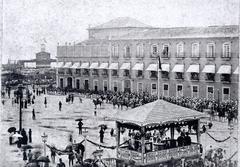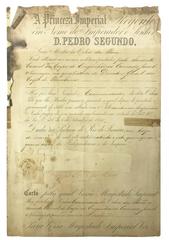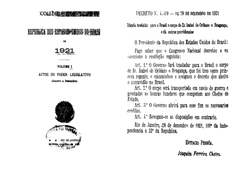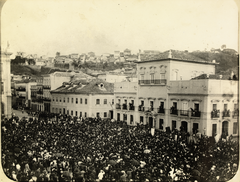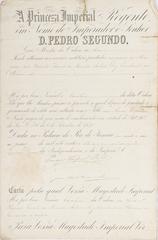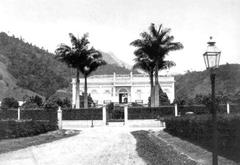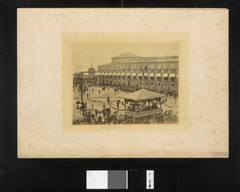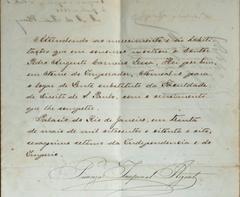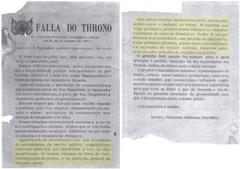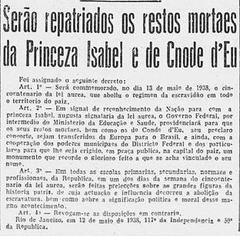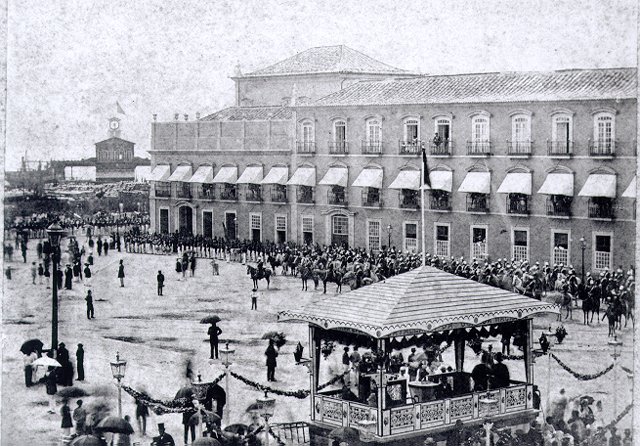
Comprehensive Guide to Visiting Ciclovia Mané Garrincha, Rio de Janeiro, Brazil
Date: 24/07/2024
Introduction
The Ciclovia Mané Garrincha in Rio de Janeiro, Brazil, is a shining example of urban innovation aimed at promoting sustainable transportation and celebrating cultural heritage. Situated in the Flamengo neighborhood, this bike path is named after the legendary Brazilian footballer Mané Garrincha, whose influence on Brazilian football and culture is profound. Inaugurated on July 6, 2014, the ciclovia forms part of Rio de Janeiro’s extensive network of bike paths spanning over 450 kilometers. This initiative enhances urban mobility, reduces traffic congestion, and provides a safe, scenic route for cyclists (Travellers Worldwide). Mané Garrincha, born in 1933, is celebrated for his extraordinary dribbling skills and charismatic personality, making him a beloved figure whose legacy transcends the football field (Off The Ball). The ciclovia not only promotes an eco-friendly mode of transportation but also serves as a platform for cultural exchange and community activities, contributing significantly to the local economy and social well-being.
Table of Contents
History and Significance of Ciclovia Mané Garrincha
Origins and Development
The Ciclovia Mané Garrincha, located in the Flamengo neighborhood of Rio de Janeiro, Brazil, is a testament to the city’s commitment to promoting sustainable transportation and honoring its rich cultural heritage. Named after the legendary Brazilian footballer Mané Garrincha, the ciclovia (bike path) was inaugurated on July 6, 2014. The development of this bike path was part of a broader initiative to enhance urban mobility and reduce traffic congestion in Rio de Janeiro. The project aimed to provide a safe and scenic route for cyclists, connecting various parts of the city and encouraging a healthier lifestyle among residents and visitors alike.
Mané Garrincha - A Cultural Icon
Mané Garrincha, born in 1933 in the town of Pau Grande, is one of Brazil’s most beloved footballers. Known for his extraordinary dribbling skills and charismatic personality, Garrincha’s legacy extends beyond the football field. His journey from a factory worker to a football legend embodies the spirit of resilience and passion that characterizes Brazilian culture. Garrincha’s impact on Brazilian football is profound, with many considering him one of the greatest players of all time. His story is a source of inspiration for many, and the naming of the ciclovia in his honor reflects his enduring influence on Brazilian society (Off The Ball).
Urban Mobility and Environmental Impact
The Ciclovia Mané Garrincha is part of Rio de Janeiro’s extensive network of bike paths, which spans over 450 kilometers. This network is designed to promote cycling as a viable and eco-friendly mode of transportation. By providing dedicated lanes for cyclists, the city aims to reduce the reliance on motor vehicles, thereby decreasing air pollution and traffic congestion. The ciclovia also offers a scenic route along the coastline, providing cyclists with stunning views of the Atlantic Ocean and the iconic Sugarloaf Mountain. This integration of natural beauty and urban infrastructure enhances the overall experience for cyclists and encourages more people to adopt cycling as a regular mode of transport (Travellers Worldwide).
Social and Economic Benefits
The establishment of the Ciclovia Mané Garrincha has had significant social and economic benefits for the local community. By promoting cycling, the city has created new opportunities for local businesses, such as bike rental shops, cafes, and tour operators. These businesses cater to both residents and tourists, contributing to the local economy. Additionally, the ciclovia provides a safe and accessible space for people of all ages to engage in physical activity, promoting a healthier lifestyle and fostering a sense of community. The bike path also serves as a venue for various events and activities, such as cycling races and community gatherings, further enhancing its role as a social hub.
Integration with Public Transportation
One of the key features of the Ciclovia Mané Garrincha is its integration with Rio de Janeiro’s public transportation system. The bike path is strategically connected to several metro and bus stations, making it easy for cyclists to combine cycling with other forms of transportation. This seamless integration encourages more people to use public transportation, reducing the overall carbon footprint of the city. The availability of bike racks and parking facilities at these stations further supports this multimodal approach to urban mobility. By providing a convenient and efficient transportation network, Rio de Janeiro is making significant strides towards becoming a more sustainable and livable city (Travellers Worldwide).
Promoting Tourism and Cultural Exchange
The Ciclovia Mané Garrincha is not only a functional piece of infrastructure but also a cultural attraction in its own right. The bike path offers tourists a unique way to explore the city, providing access to some of Rio de Janeiro’s most iconic landmarks and attractions. Cyclists can visit the famous Maracanã Stadium, the Selarón Steps, and the Jardim Botânico, among other sites, all while enjoying the scenic beauty of the city. The ciclovia also serves as a platform for cultural exchange, as tourists and locals alike share the experience of cycling through the vibrant streets of Rio de Janeiro. This interaction fosters a deeper understanding and appreciation of Brazilian culture and heritage (The Wandering Voyager).
Challenges and Future Prospects
Despite its many benefits, the Ciclovia Mané Garrincha faces several challenges. The maintenance of the bike path is crucial to ensure its safety and usability. Regular inspections and repairs are necessary to address issues such as potholes, debris, and signage. Additionally, the city must continue to promote cycling and raise awareness about the benefits of using the ciclovia. This can be achieved through public campaigns, educational programs, and incentives for cyclists. Looking ahead, there are plans to expand the network of bike paths in Rio de Janeiro, further enhancing the city’s infrastructure and promoting sustainable transportation. The success of the Ciclovia Mané Garrincha serves as a model for other cities looking to implement similar initiatives (Travellers Worldwide).
Visitor Information
Visiting Hours and Tickets
The Ciclovia Mané Garrincha is open 24 hours a day, seven days a week, providing cyclists with the flexibility to enjoy the bike path at any time. There is no entrance fee to use the ciclovia, making it an accessible attraction for everyone. However, visitors should check for any scheduled maintenance or events that might temporarily affect accessibility.
Accessibility and Travel Tips
The ciclovia is well-maintained and accessible to cyclists of all skill levels, including those with disabilities. Bike rental shops are available nearby, offering a range of bicycles for different needs and preferences. For those combining cycling with public transportation, the bike path’s connections to metro and bus stations make it easy to navigate the city. Remember to wear a helmet, stay hydrated, and follow local traffic rules to ensure a safe and enjoyable experience.
Nearby Attractions
While exploring the Ciclovia Mané Garrincha, visitors can easily access several nearby attractions. These include the Maracanã Stadium, the Selarón Steps, and the Jardim Botânico. Each of these landmarks offers a unique glimpse into Rio de Janeiro’s rich cultural and natural heritage.
Special Events and Guided Tours
The ciclovia frequently hosts special events such as cycling races, community gatherings, and cultural festivals. Guided tours are also available, providing visitors with an in-depth understanding of the bike path’s history, significance, and surrounding attractions. Check local listings or inquire at nearby tourist centers for the latest information on upcoming events and tour schedules.
Photographic Spots
Photographers will find numerous scenic spots along the Ciclovia Mané Garrincha, including breathtaking views of the Atlantic Ocean and the iconic Sugarloaf Mountain. Capture the vibrant energy of Rio de Janeiro’s streets or the serene beauty of its coastline, making your visit truly memorable.
FAQ
What are the visiting hours for Ciclovia Mané Garrincha?
The Ciclovia Mané Garrincha is open 24 hours a day, seven days a week.
How do I get to Ciclovia Mané Garrincha?
The bike path is conveniently connected to several metro and bus stations in Rio de Janeiro, making it easy to access via public transportation.
Is there an entrance fee for Ciclovia Mané Garrincha?
No, there is no entrance fee to use the ciclovia.
Are there bike rental shops nearby?
Yes, there are several bike rental shops near the Ciclovia Mané Garrincha, offering a variety of bicycles for rent.
What nearby attractions can I visit?
Nearby attractions include the Maracanã Stadium, the Selarón Steps, and the Jardim Botânico.
Conclusion
The Ciclovia Mané Garrincha stands as a testament to Rio de Janeiro’s commitment to creating a sustainable, livable city while honoring its rich cultural heritage. This bike path, named after one of Brazil’s most iconic footballers, Mané Garrincha, offers more than just a mode of transportation; it provides a scenic and safe route that connects various parts of the city, promotes healthy lifestyles, and fosters community engagement. The integration of the ciclovia with public transportation systems and its proximity to several iconic landmarks, such as the Maracanã Stadium and the Selarón Steps, make it a significant attraction for both locals and tourists. Despite challenges such as maintenance and the need for continuous promotion, the Ciclovia Mané Garrincha has proven to be a valuable asset to Rio de Janeiro, enhancing urban mobility and contributing to the city’s economic and social fabric. As the city continues to expand its network of bike paths, the ciclovia’s role in promoting sustainable transportation and cultural exchange will only grow, serving as an inspiration for other urban centers worldwide (Travellers Worldwide, The Wandering Voyager).
